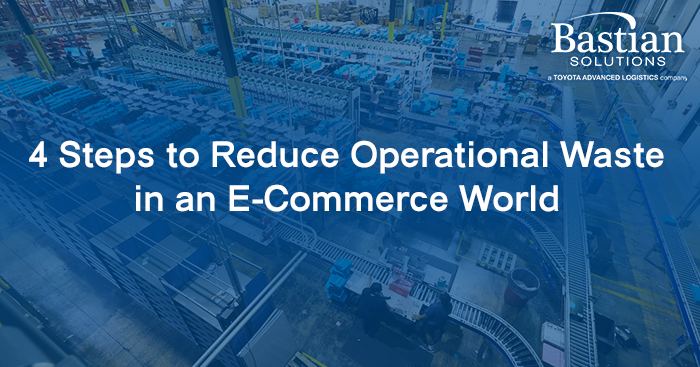
4 Steps to Reduce Operational Waste in an E-commerce World
Jordan Wengert | 08 May 2019
The Toyota Production System (TPS) uses 3Ms to characterize waste – Muda, Mura, and Muri.
- Muda is any non-value-added activity. Muda includes Transportation, Inventory, Motion, Wait Time, Overproduction, Over-processing, and Defects.
- Muri is the overburden on operators or equipment that exists when available capacity is insufficient or the required rate is unsustainable.
- An erratic, inconsistent production schedule can lead to excessive overtime hours (muri), which can cause injury, absenteeism, machine break down, etc.
- Mura is any unevenness in an operation. Mura can lead to both Muda and Muri.
- In the previous example, the mura is the inconsistent production schedule.
- Another example is a process bottleneck.
Forecasting sales within the e-commerce world can be difficult. The unpredictable demand coupled with the customer’s desire for a quick lead time makes the challenge to reduce the 3Ms more difficult.
Draw on TPS tools and principles, I’ve outlined below four steps that can be used to enhance understanding and establish a plan to reduce the 3Ms of waste for an e-commerce organization.
1. Establish a ‘goal’ takt time
Takt time is the rate you must produce or ship product to meet customer demand.
- Deep dive the historical data and look for useful trends. i.e. Pareto your top SKUs, top order months/days, etc.
- Determine what level of throughput aligns with other organizational goals.
- Confirm the system’s processes are all capable of performing to the desired rate.
2. Value stream map (VSM) customer orders
Value stream mapping is a tool to gain insight about the entire process and helps prioritize waste reduction opportunities.
- Go to the spot where the work is being done to enhance your understanding.
- Map out the step-by-step process from order receipt to receipt by the customer.
- How does information and material flow? What are the batch sizes, cycle times, etc?
- Map real orders as it will help you see what’s happening and eliminate any prejudgments.
- Always be on the lookout for the 3Ms!
3. Gain the organization’s collective support and execute the plan
- You’ve determined the desired throughput and identified several areas for improvement, now it’s time to get everyone aligned on a path forward so all initiatives complement one another.
- For example, how could sales/marketing help promote a more level-loaded production schedule for operations?
- Communicate, communicate, communicate.
- Understand operational limitations, capacities, etc.
- Offer incentives that support operations.
- Full box/truck shipments, charges for expedited orders, avoid cyclical discounts, etc.
4. Be flexible and ready to adjust
- Monitor the results and know what operations can and can’t achieve.
- Maintain playbook(s) to satisfy the demand extremes.
- Last, in the spirit of the plan-do-check-act cycle, always reflect on what went well and what didn’t. Apply those lessons learned, try new experiments, and continue to get better!
By reducing waste, a company will experience tangible results (i.e. lower costs, reduced lead times, etc.). Perhaps more importantly though, a company will improve their problem-solving capabilities and culture, making them more adaptable to future challenges.
Jordan is a Bastian Solutions Field Application Engineer in Columbus, Ohio. In his role, he helps customers improve the flow of people, information, and material throughout their operations. Jordan has a Bachelor of Science in Industrial Engineering from Iowa State University and has 10 years of manufacturing and material handling experience.
Comments
No comments have been posted to this Blog Post
Leave a Reply
Your email address will not be published.
Comment
Thank you for your comment.